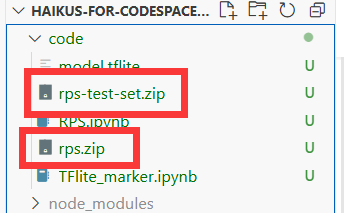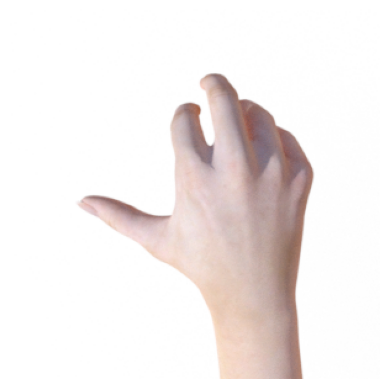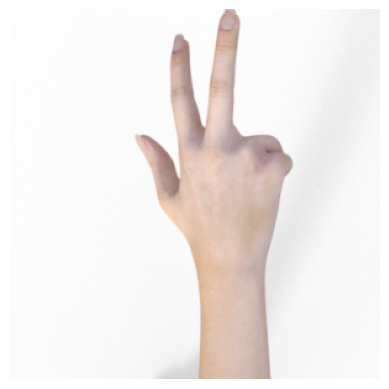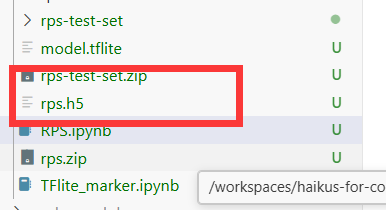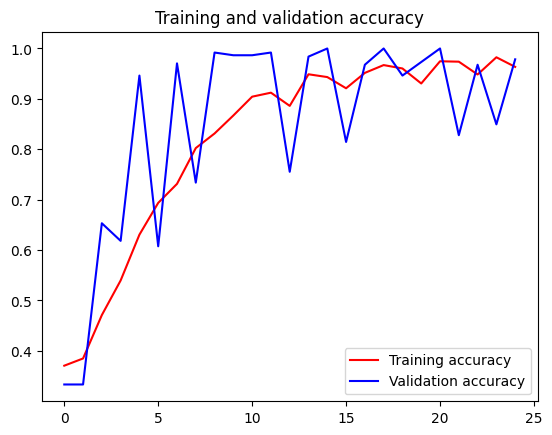在终端内输入命令,将石头剪刀布的训练集和测试集下载至当前目录:wget --no-check-certificate https://storage.googleapis.com/learning-datasets/rps.zip -O ./rps.zipwget --no-check-certificate https://storage.googleapis.com/learning-datasets/rps-test-set.zip -O ./rps-test-set.zip
通过下面代码解压数据集到当前目录:
import os
import zipfile
local_zip = './rps.zip'
zip_ref = zipfile.ZipFile(local_zip, 'r')
zip_ref.extractall('./')
zip_ref.close()
local_zip = './rps-test-set.zip'
zip_ref = zipfile.ZipFile(local_zip, 'r')
zip_ref.extractall('./')
zip_ref.close()打印数据集的相关信息以验证数据集的完整性。
rock_dir = os.path.join('./rps/rock')
paper_dir = os.path.join('./rps/paper')
scissors_dir = os.path.join('./rps/scissors')
# 各手势数据集包含的图片张数
print('total training rock images:', len(os.listdir(rock_dir)))
print('total training paper images:', len(os.listdir(paper_dir)))
print('total training scissors images:', len(os.listdir(scissors_dir)))
# 输出各数据集的前5张图片的文件名
rock_file = os.listdir(rock_dir)
rock_file.sort()
print(rock_file[:5])
paper_file = os.listdir(paper_dir)
paper_file.sort()
print(paper_file[:5])
scissors_file = os.listdir(scissors_dir)
scissors_file.sort()
print(scissors_file[:5])total training rock images: 840
total training paper images: 840
total training scissors images: 840
['rock01-000.png', 'rock01-001.png', 'rock01-002.png', 'rock01-003.png', 'rock01-004.png']
['paper01-000.png', 'paper01-001.png', 'paper01-002.png', 'paper01-003.png', 'paper01-004.png']
['scissors01-000.png', 'scissors01-001.png', 'scissors01-002.png', 'scissors01-003.png', 'scissors01-004.png']
从石头、剪刀、布训练集中分别打印两张图片:
%matplotlib inline
import matplotlib.pyplot as plt
import matplotlib.image as mpimg
pic_index = 100
next_rock = [os.path.join(rock_dir, fname)
for fname in rock_file[pic_index-2:pic_index]]
next_paper = [os.path.join(paper_dir, fname)
for fname in paper_file[pic_index-2:pic_index]]
next_scissors = [os.path.join(scissors_dir, fname)
for fname in scissors_file[pic_index-2:pic_index]]
for i, img_path in enumerate(next_rock + next_paper + next_scissors):
img = mpimg.imread(img_path)
plt.imshow(img)
plt.axis('Off')
plt.show()调用TensorFlow的keras进行数据模型的训练,ImageDataGenerator是Keras中图像预处理的类,经过预处理使得后续的训练更加准确。
import tensorflow as tf
import keras_preprocessing
from keras_preprocessing import image
from keras_preprocessing.image import ImageDataGenerator
TRAINING_DIR = './rps/'
# 图片预处理
training_datagen = ImageDataGenerator(
rescale=1./255,
rotation_range=40,
width_shift_range=0.2,
height_shift_range=0.2,
shear_range=0.2,
zoom_range=0.2,
horizontal_flip=True,
fill_mode='nearest'
)
VALIDATION_DIR = "./rps-test-set/"
validation_datagen = ImageDataGenerator(rescale = 1./255)
train_generator = training_datagen.flow_from_directory(
TRAINING_DIR,
target_size=(150,150),
class_mode='categorical',
batch_size=126
)
validation_generator = validation_datagen.flow_from_directory(
VALIDATION_DIR,
target_size=(150,150),
class_mode='categorical',
batch_size=126
)
# 定义模型架构
model = tf.keras.models.Sequential([
# Note the input shape is the desired size of the image 150x150 with 3 bytes color
# This is the first convolution
tf.keras.layers.Conv2D(64, (3,3), activation='relu', input_shape=(150, 150, 3)),
tf.keras.layers.MaxPooling2D(2, 2),
# The second convolution
tf.keras.layers.Conv2D(64, (3,3), activation='relu'),
tf.keras.layers.MaxPooling2D(2,2),
# The third convolution
tf.keras.layers.Conv2D(128, (3,3), activation='relu'),
tf.keras.layers.MaxPooling2D(2,2),
# The fourth convolution
tf.keras.layers.Conv2D(128, (3,3), activation='relu'),
tf.keras.layers.MaxPooling2D(2,2),
# Flatten the results to feed into a DNN
tf.keras.layers.Flatten(),
tf.keras.layers.Dropout(0.5),
# 512 neuron hidden layer
tf.keras.layers.Dense(512, activation='relu'),
tf.keras.layers.Dense(3, activation='softmax')
])
model.summary()
# 编译模型并定义相关参数
model.compile(loss = 'categorical_crossentropy', optimizer = 'rmsprop', metrics = ['accuracy'])
# 用训练数据拟合
history = model.fit(train_generator, epochs=25, steps_per_epoch=20, validation_data = validation_generator, verbose = 1, validation_steps=3)2024-05-31 11:19:08.814399: W tensorflow/stream_executor/platform/default/dso_loader.cc:64] Could not load dynamic library 'libcudart.so.11.0'; dlerror: libcudart.so.11.0: cannot open shared object file: No such file or directory
2024-05-31 11:19:08.814449: I tensorflow/stream_executor/cuda/cudart_stub.cc:29] Ignore above cudart dlerror if you do not have a GPU set up on your machine.
Found 2520 images belonging to 3 classes.
Found 372 images belonging to 3 classes.
2024-05-31 11:19:20.168223: W tensorflow/stream_executor/platform/default/dso_loader.cc:64] Could not load dynamic library 'libcuda.so.1'; dlerror: libcuda.so.1: cannot open shared object file: No such file or directory
2024-05-31 11:19:20.168268: W tensorflow/stream_executor/cuda/cuda_driver.cc:269] failed call to cuInit: UNKNOWN ERROR (303)
2024-05-31 11:19:20.168292: I tensorflow/stream_executor/cuda/cuda_diagnostics.cc:156] kernel driver does not appear to be running on this host (codespaces-4bb514): /proc/driver/nvidia/version does not exist
2024-05-31 11:19:20.168662: I tensorflow/core/platform/cpu_feature_guard.cc:151] This TensorFlow binary is optimized with oneAPI Deep Neural Network Library (oneDNN) to use the following CPU instructions in performance-critical operations: AVX2 FMA
To enable them in other operations, rebuild TensorFlow with the appropriate compiler flags.
Model: "sequential"
_________________________________________________________________
Layer (type) Output Shape Param #
=================================================================
conv2d (Conv2D) (None, 148, 148, 64) 1792
max_pooling2d (MaxPooling2D (None, 74, 74, 64) 0
)
conv2d_1 (Conv2D) (None, 72, 72, 64) 36928
max_pooling2d_1 (MaxPooling (None, 36, 36, 64) 0
2D)
conv2d_2 (Conv2D) (None, 34, 34, 128) 73856
max_pooling2d_2 (MaxPooling (None, 17, 17, 128) 0
2D)
conv2d_3 (Conv2D) (None, 15, 15, 128) 147584
max_pooling2d_3 (MaxPooling (None, 7, 7, 128) 0
2D)
flatten (Flatten) (None, 6272) 0
dropout (Dropout) (None, 6272) 0
dense (Dense) (None, 512) 3211776
dense_1 (Dense) (None, 3) 1539
=================================================================
Total params: 3,473,475
Trainable params: 3,473,475
Non-trainable params: 0
_________________________________________________________________
2024-05-31 11:19:21.801546: W tensorflow/core/framework/cpu_allocator_impl.cc:82] Allocation of 34020000 exceeds 10% of free system memory.
Epoch 1/25
2024-05-31 11:19:25.190819: W tensorflow/core/framework/cpu_allocator_impl.cc:82] Allocation of 34020000 exceeds 10% of free system memory.
2024-05-31 11:19:25.210296: W tensorflow/core/framework/cpu_allocator_impl.cc:82] Allocation of 706535424 exceeds 10% of free system memory.
2024-05-31 11:19:26.339031: W tensorflow/core/framework/cpu_allocator_impl.cc:82] Allocation of 176633856 exceeds 10% of free system memory.
2024-05-31 11:19:26.516623: W tensorflow/core/framework/cpu_allocator_impl.cc:82] Allocation of 167215104 exceeds 10% of free system memory.
20/20 [==============================] - 131s 6s/step - loss: 1.2608 - accuracy: 0.3706 - val_loss: 1.0801 - val_accuracy: 0.3333
Epoch 2/25
20/20 [==============================] - 118s 6s/step - loss: 1.1010 - accuracy: 0.3849 - val_loss: 1.0713 - val_accuracy: 0.3333
Epoch 3/25
20/20 [==============================] - 124s 6s/step - loss: 1.0885 - accuracy: 0.4710 - val_loss: 0.7870 - val_accuracy: 0.6532
Epoch 4/25
20/20 [==============================] - 118s 6s/step - loss: 0.9760 - accuracy: 0.5397 - val_loss: 0.8186 - val_accuracy: 0.6183
Epoch 5/25
20/20 [==============================] - 117s 6s/step - loss: 0.8621 - accuracy: 0.6306 - val_loss: 0.4621 - val_accuracy: 0.9462
Epoch 6/25
20/20 [==============================] - 119s 6s/step - loss: 0.6611 - accuracy: 0.6937 - val_loss: 0.8699 - val_accuracy: 0.6075
Epoch 7/25
20/20 [==============================] - 120s 6s/step - loss: 0.5948 - accuracy: 0.7313 - val_loss: 0.3731 - val_accuracy: 0.9704
Epoch 8/25
20/20 [==============================] - 117s 6s/step - loss: 0.5071 - accuracy: 0.8024 - val_loss: 0.4726 - val_accuracy: 0.7339
Epoch 9/25
20/20 [==============================] - 118s 6s/step - loss: 0.4129 - accuracy: 0.8313 - val_loss: 0.0822 - val_accuracy: 0.9919
Epoch 10/25
20/20 [==============================] - 119s 6s/step - loss: 0.3248 - accuracy: 0.8671 - val_loss: 0.0924 - val_accuracy: 0.9866
Epoch 11/25
20/20 [==============================] - 119s 6s/step - loss: 0.2439 - accuracy: 0.9044 - val_loss: 0.0476 - val_accuracy: 0.9866
Epoch 12/25
20/20 [==============================] - 118s 6s/step - loss: 0.2323 - accuracy: 0.9123 - val_loss: 0.0428 - val_accuracy: 0.9919
Epoch 13/25
20/20 [==============================] - 119s 6s/step - loss: 0.3379 - accuracy: 0.8861 - val_loss: 0.5081 - val_accuracy: 0.7554
Epoch 14/25
20/20 [==============================] - 117s 6s/step - loss: 0.1513 - accuracy: 0.9488 - val_loss: 0.0623 - val_accuracy: 0.9839
Epoch 15/25
20/20 [==============================] - 118s 6s/step - loss: 0.1596 - accuracy: 0.9433 - val_loss: 0.0298 - val_accuracy: 1.0000
Epoch 16/25
20/20 [==============================] - 120s 6s/step - loss: 0.2229 - accuracy: 0.9210 - val_loss: 0.3965 - val_accuracy: 0.8145
Epoch 17/25
20/20 [==============================] - 118s 6s/step - loss: 0.1388 - accuracy: 0.9516 - val_loss: 0.1016 - val_accuracy: 0.9677
Epoch 18/25
20/20 [==============================] - 118s 6s/step - loss: 0.0923 - accuracy: 0.9671 - val_loss: 0.0179 - val_accuracy: 1.0000
Epoch 19/25
20/20 [==============================] - 120s 6s/step - loss: 0.1217 - accuracy: 0.9603 - val_loss: 0.1435 - val_accuracy: 0.9462
Epoch 20/25
20/20 [==============================] - 118s 6s/step - loss: 0.2032 - accuracy: 0.9306 - val_loss: 0.0654 - val_accuracy: 0.9731
Epoch 21/25
20/20 [==============================] - 117s 6s/step - loss: 0.0822 - accuracy: 0.9746 - val_loss: 0.0143 - val_accuracy: 1.0000
Epoch 22/25
20/20 [==============================] - 117s 6s/step - loss: 0.0809 - accuracy: 0.9738 - val_loss: 0.3009 - val_accuracy: 0.8280
Epoch 23/25
20/20 [==============================] - 117s 6s/step - loss: 0.1456 - accuracy: 0.9484 - val_loss: 0.0570 - val_accuracy: 0.9677
Epoch 24/25
20/20 [==============================] - 118s 6s/step - loss: 0.0575 - accuracy: 0.9825 - val_loss: 0.3360 - val_accuracy: 0.8495
Epoch 25/25
20/20 [==============================] - 122s 6s/step - loss: 0.1039 - accuracy: 0.9635 - val_loss: 0.0419 - val_accuracy: 0.9785
将生成的模型以h5格式保存到当前目录
model.save("rps.h5")通过绘制图形的方式,验证生成模型的性能
import matplotlib.pyplot as plt
acc = history.history['accuracy']
val_acc = history.history['val_accuracy']
loss = history.history['loss']
val_loss = history.history['val_loss']
epochs = range(len(acc))
plt.plot(epochs, acc, 'r', label='Training accuracy')
plt.plot(epochs, val_acc, 'b', label='Validation accuracy')
plt.title('Training and validation accuracy')
plt.legend(loc=0)
plt.figure()
plt.show()<Figure size 432x288 with 0 Axes>



